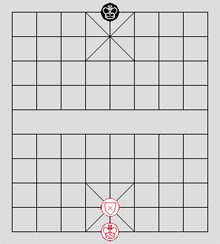|
Spil dette spil
Chinese Chess (Xiangqi)Xiangqi, or Chinese Chess, is a very popular game in Asian countries. It is believed that both Xiangqi and classic western Chess had been developed from the original Indian game of Chanturanga.Start position and game object Xiangqi is played on rectangular 9x10 board. Unlike at western Chess, the pieces are placed on line intersections, not squares. Each player starts the game with these pieces: 1 king (or general), 2 guards (or advisors), 2 elephants (or bishops), 2 knights (or horses), 2 rooks (or chariots), 2 cannons and 5 pawns (or soldiers). The starting position is shown on the following picture:  The small squares containing diagonal lines are called red and black palace, and the thick horizontal line in the middle of the board is named "river". The object of the game is to checkmate or stalemate the opponent's king. Movement of pieces All pieces in Xiangqi (except the cannon) use the same rules for both moving and capturing enemy pieces. Cannons have a special rule which will be clarified below. King (General)  A king moves one space vertically or horizontally, it cannot move diagonally. It may never leave its palace. As in standard Chess, a king is not allowed to make a move to a position which is being attacked by an enemy piece. If a king is being attacked (is in check), the corresponding player must cancel the check immediately. If it is not possible, the player loses the game.
A king moves one space vertically or horizontally, it cannot move diagonally. It may never leave its palace. As in standard Chess, a king is not allowed to make a move to a position which is being attacked by an enemy piece. If a king is being attacked (is in check), the corresponding player must cancel the check immediately. If it is not possible, the player loses the game.Guard (Advisor)  A guard moves one space diagonally and just like a king, it may never leave its palace. In other words, each guard has only 5 possible positions within the palace area.
A guard moves one space diagonally and just like a king, it may never leave its palace. In other words, each guard has only 5 possible positions within the palace area.Bishop (Elephant)  Elephants can move exactly two spaces diagonally and they cannot cross occupied points. Moreover, elephants are not allowed to cross the river, they must stay on their half of the board. It means that each elephant has only 7 possible positions.
Elephants can move exactly two spaces diagonally and they cannot cross occupied points. Moreover, elephants are not allowed to cross the river, they must stay on their half of the board. It means that each elephant has only 7 possible positions.Knight (Horse) 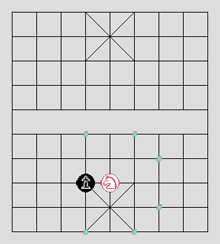 A knight moves one space vertically or horizontally, followed by one space outward-diagonally. There is a significant difference between western Chess and Xiangqi because a knight cannot jump over occupied places. The picture shows (in green points) all possible moves of the red knight, since the black pawn blocks the left side ones.
A knight moves one space vertically or horizontally, followed by one space outward-diagonally. There is a significant difference between western Chess and Xiangqi because a knight cannot jump over occupied places. The picture shows (in green points) all possible moves of the red knight, since the black pawn blocks the left side ones.Rook (Chariot) 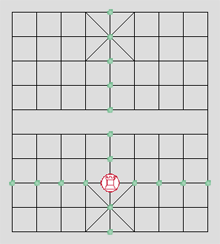 A rook moves as a rook in standard Chess - any number of spaces vertically or horizontally.
A rook moves as a rook in standard Chess - any number of spaces vertically or horizontally.
Cannon 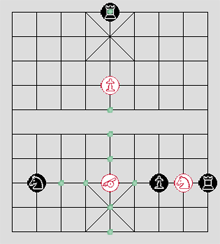 A cannon moves in the same way as a rook. However, if a cannon wants to capture an opponent's piece, it must be done by hoping over exactly one another piece (own or opponent's). The picture shows a position where all possible red cannon moves (or captures) marked by green dots (note a green dot inside the black rook at the board top).
A cannon moves in the same way as a rook. However, if a cannon wants to capture an opponent's piece, it must be done by hoping over exactly one another piece (own or opponent's). The picture shows a position where all possible red cannon moves (or captures) marked by green dots (note a green dot inside the black rook at the board top).The black knight on the left side cannot be captured because no third piece stands between it and the cannon. The top black rook can be captured since the cannon hops over the red pawn. On the other hand, the second black rook (on the right) cannot be captured since the cannon would hop over more than one piece (black pawn and red knight). Pawn (Soldier) 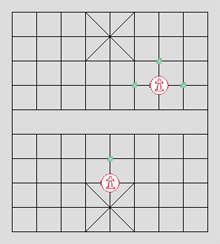 Pawns move only one space forward and their capture moves are just the same (they never go diagonally). When a pawn crosses the river, its moving abilities extend by sideways options - it can move one space forward or horizontally.
Pawns move only one space forward and their capture moves are just the same (they never go diagonally). When a pawn crosses the river, its moving abilities extend by sideways options - it can move one space forward or horizontally.Pawns don't promote in Xiangqi. When a pawn reaches the last row, it can continue moving only sideways. Other important rules
Spil dette spil Se også: Skak, Kinesisk skak, Japansk skak, Hjørne skak, Fort skak, Horde skak, Loop skak, Anti skak, Udryddelsesskak, Maharajah skak, Treskaks skak, Mørk skak, Atom skak, Janus skak, Ambassade skak, Fribræt skak, Vildt fribræt skak, Cylinder skak, Amazon skak, Berolina skak, Fischer Random skak, Legan Skak, Springer stafet skak, Storskak, Capablanca Random Skak, Los Alamos Skak, Modstridende skak, Minishogi, Terninge Skak, Genbrugs Skak, Istids Skak, Behemoth Skak, Cheshire Cat Chess, Knightmate Chess, Racing Kings, Dice Chess 10x10, Massacre Chess |
Dato og klokkeslæt
Venner online
Favoritborde
Sammenslutninger
Dagens tip
|
|
||||||||||||||||||||||||||||||||||||||||||||||||||||||||||||||||||||||||||
Copyright © 2002 - 2025 Filip Rachunek, all rights reserved. Tilbage til toppen |
